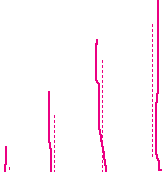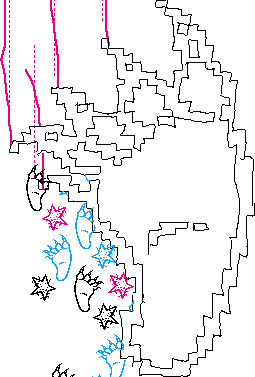| (1) GENERATION FLASH (2) FAQ (3) UTOPIA IN SOFWARE (4) THE UNBEARABLE LIGHTNESS OF FLASH (5) ART, MEDIA AND SOFTWARE ART (6) POSTSCRIPT LEV MANOVICH, 2002 (7) WEBSITES, THE ART OF OUR TIMES MILTOS MANETAS , 2002 (8) FLASH IS POPTECH PETER LUNENFELD, 2001
Postscript: On The Lightness of Flash by Lev Manovich
When I first visited the most famous Flash site – praystation.net – I was struck by the lightness of its graphics. More quite when whisper, more elegant than Door or Channel, more minimal than 1960s minimalist sculptures of Judd, more subdued than the winter landscape in heavy fog, the site pushed the contrast scale to the limits of legibility. The similar lightness and restrain can be found in many projects included in Biennale 01 show. Again, the contrast with screaming graphics of commercial media and the media art of the previous generations is obvious.
The lightness of Flash can be thought of as a visual equivalent of electronic ambient music. Every line and every pixel counts. Flash appeals to our visual intelligence - and cognitive intelligence. After the century of RGB color which begun with Mantises and ended with aggressive spreads of Wired, we are asked to start over, to begin from scratch. Flash generation invites us to undergo a visual cleansing – this is why we see a monochrome palette, white and light gray. It uses neo-minimalism as a pill to cure us from postmodernism. In Flash, the rationality of modernism is combined with the rationality of programming and the affect of computer games to create the new aesthetics of lightness, curiosity and intelligence. Make sure your browser have the right plug-in: welcome to generation Flash. I am not advocating a revival of modernism. Of course we don't want to simply replay Mondrian and Klee on computer screens. The task of the new generation is to integrate the two key aesthetic paradigms of the twentieth century: (1) belief in science and rationality, emphasis on efficiency and basic forms, idealism and heroic spirit of modernism; (2) skepticism, interest in “marginality” and “complexity,” deconstructive strategies, baroque opaqueness and excess of postmodernism (1960s-). At this point all the features of the second paradigm became tired clichés. Therefore a partial return to modernism is not a bad first step, as long as it is just a first step towards developing the new aesthetics for the new age. Of course this aesthetics should also fully engage with the difficult questions of globalization. The remix culture we are living now is not only engaged in remixing all previous cultural forms and texts of but also in remixing various features which come from what used to be call national cultures as well as from already existing remixes between immigrant populations and their “host” cultures. The solution offered by multinational conglomerates – a composite which takes certain signifiers from a few national cultures – for instance, French idea of elegance, Japanese manga iconography, “cool Britannia” references, and so on, and integrates it all into a rather bland and monolithic text which is then being send back to all the places around the world – is obviously not a satisfactory solution. (It reminds me of Soviet-style centralized economy when the all the output of collective farms was send to the center where it was decided how it was distributed nationally.) Luckily, numerous remixes which follow different logics are being explored around the world by musicians, theater groups, dancers, designers, architects, and so on. Nobody knows what will emerge from this global cultural laboratory – and this is what makes out times so interesting. Although most of my arguments in this book are about visual culture and visual aesthetics, it is relevant at this point to evoke a different practice. Music historically has been the artistic field that was always been ahead of other fields in using computers to enable new aesthetic paradigms. The whole practice of popular electronic music in the last three decades is a testament to how empowering new technologies are in welding new complex and rich remixes between different cultures, styles, and sensibilities. Without electronic and computing technologies – from a turntable and a tape recorder to peer-to-peer file sharing networks and music synthesis software running on a regular laptop, most of this culture would never come to be. The field of electronic sound (which pretty much means most sounds today) with its multitude voices and a real bottom-up, “emergent” logic, Is a powerful alternative to the “top-down” cultural composites sold by global media conglomerates around the world. Let us hope that other artists and designers in other fields will follow music lead in using a computer to enable similarly rich remix cultures. |
![]()
 |
 |
 |